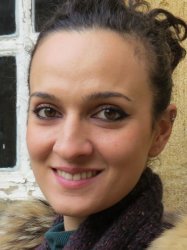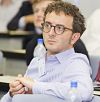Studying at the University of Verona
Here you can find information on the organisational aspects of the Programme, lecture timetables, learning activities and useful contact details for your time at the University, from enrolment to graduation.
Academic calendar
The academic calendar shows the deadlines and scheduled events that are relevant to students, teaching and technical-administrative staff of the University. Public holidays and University closures are also indicated. The academic year normally begins on 1 October each year and ends on 30 September of the following year.
Course calendar
The Academic Calendar sets out the degree programme lecture and exam timetables, as well as the relevant university closure dates..
| Period | From | To |
|---|---|---|
| primo semestre (lauree magistrali) | Oct 5, 2020 | Dec 23, 2020 |
| secondo semestre (lauree magistrali) | Mar 1, 2021 | Jun 1, 2021 |
| Session | From | To |
|---|---|---|
| sessione invernale | Jan 11, 2021 | Feb 12, 2021 |
| sessione estiva | Jun 7, 2021 | Jul 23, 2021 |
| sessione autunnale | Aug 23, 2021 | Sep 17, 2021 |
| Session | From | To |
|---|---|---|
| sessione autunnale (validità a.a. 2019/20) | Dec 9, 2020 | Dec 11, 2020 |
| sessione invernale (validità a.a. 2019/20) | Apr 7, 2021 | Apr 9, 2021 |
| sessione estiva (validità a.a. 2020/21) | Sep 6, 2021 | Sep 8, 2021 |
| Period | From | To |
|---|---|---|
| Vacanze di Natale | Dec 24, 2020 | Jan 6, 2021 |
| Vacanze di Pasqua | Apr 3, 2021 | Apr 6, 2021 |
| Vacanze estive | Aug 9, 2021 | Aug 15, 2021 |
Exam calendar
Exam dates and rounds are managed by the relevant Economics Teaching and Student Services Unit.
To view all the exam sessions available, please use the Exam dashboard on ESSE3.
If you forgot your login details or have problems logging in, please contact the relevant IT HelpDesk, or check the login details recovery web page.
Should you have any doubts or questions, please check the Enrollment FAQs
Academic staff
 laura.chiaramonte@univr.it
laura.chiaramonte@univr.it
 mauro.cortese@univr.it
mauro.cortese@univr.it
 cecilia.mancini@univr.it
cecilia.mancini@univr.it

Santi Flavio
 flavio.santi@univr.it
flavio.santi@univr.it
 045 802 8239
045 802 8239

Vannucci Virginia
 virginia.vannucci@univr.it
virginia.vannucci@univr.it
Study Plan
The Study Plan includes all modules, teaching and learning activities that each student will need to undertake during their time at the University.
Please select your Study Plan based on your enrollment year.
1° Year
| Modules | Credits | TAF | SSD |
|---|
2° Year activated in the A.Y. 2021/2022
| Modules | Credits | TAF | SSD |
|---|
| Modules | Credits | TAF | SSD |
|---|
| Modules | Credits | TAF | SSD |
|---|
| Modules | Credits | TAF | SSD |
|---|
Legend | Type of training activity (TTA)
TAF (Type of Educational Activity) All courses and activities are classified into different types of educational activities, indicated by a letter.
Type D and Type F activities
| years | Modules | TAF | Teacher |
|---|---|---|---|
| 1° 2° | Future matters | D |
Alessandro Bucciol
(Coordinator)
|
| 1° 2° | Future matters | D |
Alessandro Bucciol
(Coordinator)
|
| years | Modules | TAF | Teacher |
|---|---|---|---|
| 1° 2° | The fashion lab (1 ECTS) | D |
Maria Caterina Baruffi
(Coordinator)
|
| 1° 2° | The fashion lab (2 ECTS) | D |
Maria Caterina Baruffi
(Coordinator)
|
| 1° 2° | The fashion lab (3 ECTS) | D |
Maria Caterina Baruffi
(Coordinator)
|
| years | Modules | TAF | Teacher |
|---|---|---|---|
| 1° 2° | Design and Evaluation of Economic and Social Policies | D |
Federico Perali
(Coordinator)
|
| 1° 2° | Public debate and scientific writing - 2020/2021 | D |
Martina Menon
(Coordinator)
|
| 1° 2° | Wake up Italia - 2020/2021 | D |
Sergio Noto
(Coordinator)
|
Financial statistics (2021/2022)
Teaching code
4S00489
Teacher
Coordinator
Credits
9
Language
Italian
Scientific Disciplinary Sector (SSD)
SECS-S/03 - ECONOMIC STATISTICS
Period
primo semestre (lauree magistrali) dal Oct 4, 2021 al Dec 17, 2021.
Learning outcomes
The goal of the course is to introduce students to the modern econometric and time series tools for analyzing and modeling financial returns and volatility. The course provides students with theoretical and practical knowledge of the statistical and computational skills needed for the identification, estimation and test of stochastic processes used by the financial operators to manage risk and develop investment strategies. At the end of the course, students will be able to critically compare the price dynamic of different assets and to estimate the parameters of the stochastic processes that captures the main stylized facts observed in the financial markets.
Program
1. Prices and index numbers
* Prices and returns
* Moving averages
* Index numbers and stock indexes
2. Probability and inference
* Stochastic processes
* Estimation theory and likelihood principle
3. Risk measures and validation of statistical models
* Risk measures
* Monte Carlo
* Cross-validation and backtesting
4. Analysis of returns: empirical facts
* Unconditional distribution of returns
* Time dependence and autocorrelation function
* Correlograms
5. Analysis of returns: stochastic mean models
* Stochastc processes: iid, AR, MA and ARMA
* Identification and fitting of ARMA processes
* Conditional risk measures on ARMA processes
6. Analysis of returns: stochastic variance models
* Stochastic processes: ARCH and GARCH
* Identification and fitting of GARCH processes
* Conditional risk measures on GARCH and ARMA-GARCH processes
7. Introduction to extreme value theory
* Heavy-tailed distributions and risk measures
* Parametric and semiparametric models of conditional risk measures
* Generalised Pareto distribution
Methods and techniques illustrated throughout the course are applied to real data by means of the open source environment R.
Bibliography
Examination Methods
The assessment of learning outcomes consists in a written examination.
Examination purposes
The written examination assesses the level of knowledge of the course topics, the ability to analyse financial time series by means of the methods illustrated in the course and the ability to interpret the results of the analyses.
Structure of the examination
The examination consists of single and multiple choice questions, questions which requires a numerical response, and open-ended questions. All kinds of questions may be focussed on theoretical and methodological issues, may consist in exercises, or may require the student to discuss and analyse some practical problem using notions and tools learned throughout the course.
The teacher may require students to take an oral examination which completes the evaluation of the acquired knowledge. The final grade may be equal, higher or lower than the grade got on the written part of the exam.
Assessment criteria
The examination score is on a 30-point scale (passing mark: 18).
Career prospects
Module/Programme news
News for students
There you will find information, resources and services useful during your time at the University (Student’s exam record, your study plan on ESSE3, Distance Learning courses, university email account, office forms, administrative procedures, etc.). You can log into MyUnivr with your GIA login details: only in this way will you be able to receive notification of all the notices from your teachers and your secretariat via email and soon also via the Univr app.
Graduation
List of theses and work experience proposals
| theses proposals | Research area |
|---|---|
| Tesi di laurea magistrale - Tecniche e problemi aperti nel credit scoring | Statistics - Foundational and philosophical topics |
| Fattori ESG e valutazione d'azienda | Various topics |
| Il metodo Monte Carlo per la valutazione di opzioni americane | Various topics |
| Il Minimum Requirement for own funds and Eligible Liabilities (MREL) | Various topics |
| L'acquisto di azioni proprie | Various topics |
| Proposte Tesi A. Gnoatto | Various topics |






















